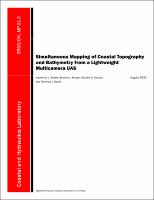Please use this identifier to cite or link to this item:
https://hdl.handle.net/11681/41440Full metadata record
| DC Field | Value | Language |
|---|---|---|
| dc.contributor.author | Brodie, Katherine L. | - |
| dc.contributor.author | Bruder, Brittany L. | - |
| dc.contributor.author | Slocum, Richard K. | - |
| dc.contributor.author | Spore, Nicholas J. | - |
| dc.date.accessioned | 2021-08-09T15:09:56Z | - |
| dc.date.available | 2021-08-09T15:09:56Z | - |
| dc.date.issued | 2021-08 | - |
| dc.identifier.govdoc | ERDC/CHL MP-21-3 | - |
| dc.identifier.uri | https://hdl.handle.net/11681/41440 | - |
| dc.identifier.uri | http://dx.doi.org/10.21079/11681/41440 | - |
| dc.description | Miscellaneous Paper | en_US |
| dc.description.abstract | A low-cost multicamera Unmanned Aircraft System (UAS) is used to simultaneously estimate open-coast topography and bathymetry from a single longitudinal coastal flight. The UAS combines nadir and oblique imagery to create a wide field of view (FOV), which enables collection of mobile, long dwell timeseries of the littoral zone suitable for structure-from motion (SfM), and wave speed inversion algorithms. Resultant digital surface models (DSMs) compare well with terrestrial topographic lidar and bathymetric survey data at Duck, NC, USA, with root-mean-square error (RMSE)/bias of 0.26/–0.05 and 0.34/–0.05 m, respectively. Bathymetric data from another flight at Virginia Beach, VA, USA, demonstrates successful comparison (RMSE/bias of 0.17/0.06 m) in a secondary environment. UAS-derived engineering data products, total volume profiles and shoreline position, were congruent with those calculated from traditional topo-bathymetric surveys at Duck. Capturing both topography and bathymetry within a single flight, the presented multicamera system is more efficient than data acquisition with a single camera UAS; this advantage grows for longer stretches of coastline (10 km). Efficiency increases further with an on-board Global Navigation Satellite System–Inertial Navigation System (GNSS-INS) to eliminate ground control point (GCP) placement. The Appendix reprocesses the Virginia Beach flight with the GNSS–INS input and no GCPs. | en_US |
| dc.description.sponsorship | United States. Army. Corps of Engineers. | en_US |
| dc.format.extent | 26 pages / 2.93 MB | - |
| dc.format.medium | PDF/A | - |
| dc.language.iso | en_US | en_US |
| dc.publisher | Coastal and Hydraulics Laboratory (U.S.) | en_US |
| dc.publisher | Engineer Research and Development Center (U.S.) | - |
| dc.relation.ispartofseries | Miscellaneous Paper (Engineer Research and Development Center (U.S.)) ; no. ERDC/CHL MP-21-3 | - |
| dc.relation.isversionof | Brodie, Katherine L., Brittany L. Bruder, Richard K. Slocum, and Nicholas J. Spore. "Simultaneous mapping of coastal topography and bathymetry from a lightweight multicamera uas." IEEE Transactions on Geoscience and Remote Sensing 57, no. 9 (2019): 6844-6864. https://ieeexplore.ieee.org/abstract/document/8726410 | - |
| dc.rights | Approved for Public Release; Distribution is Unlimited | - |
| dc.source | This Digital Resource was created in Microsoft Word and Adobe Acrobat | - |
| dc.subject | Coastal mapping | en_US |
| dc.subject | Multiview stereo (MVS) | en_US |
| dc.subject | Nearshore morphology | en_US |
| dc.subject | Remote sensing | en_US |
| dc.subject | Structure from motion (SfM) | en_US |
| dc.subject | Unmanned Aircraft Systems (UAS) | en_US |
| dc.title | Simultaneous mapping of coastal topography and bathymetry from a lightweight multicamera UAS | en_US |
| dc.type | Report | en_US |
| Appears in Collections: | Miscellaneous Paper | |
Files in This Item:
| File | Description | Size | Format | |
|---|---|---|---|---|
| ERDC-CHL MP-21-3.pdf | 2.93 MB | Adobe PDF |  View/Open |